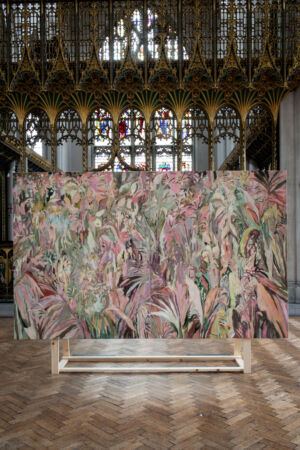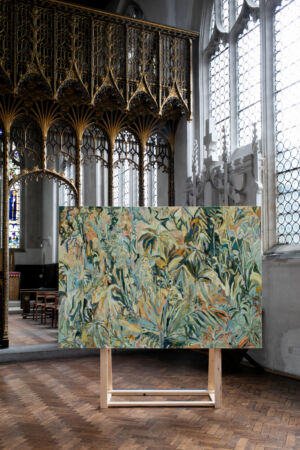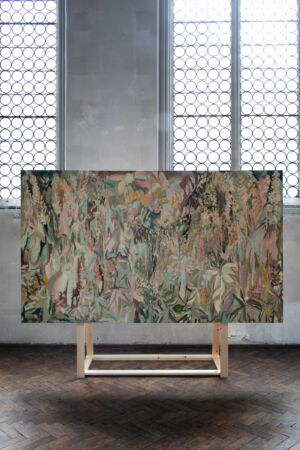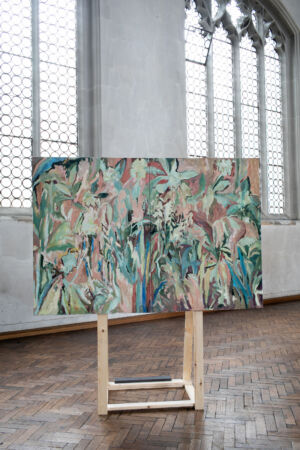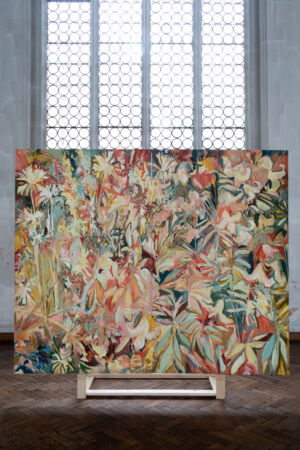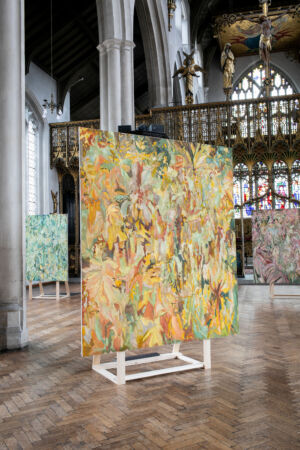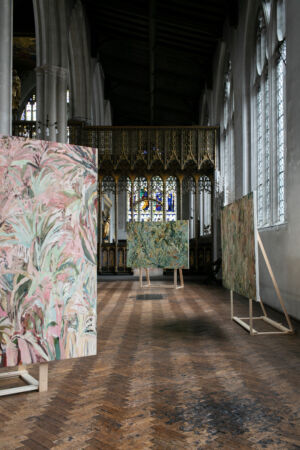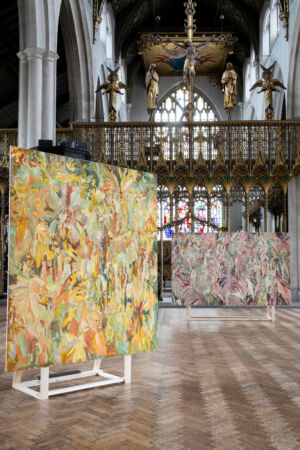Beatrice Hasell-McCosh
‘andante’
Curated by Jenn Ellis
Exhibition July 3 – 27, 2024. Saint Cyprian’s Church, Glentworth St, London NW1 6AX
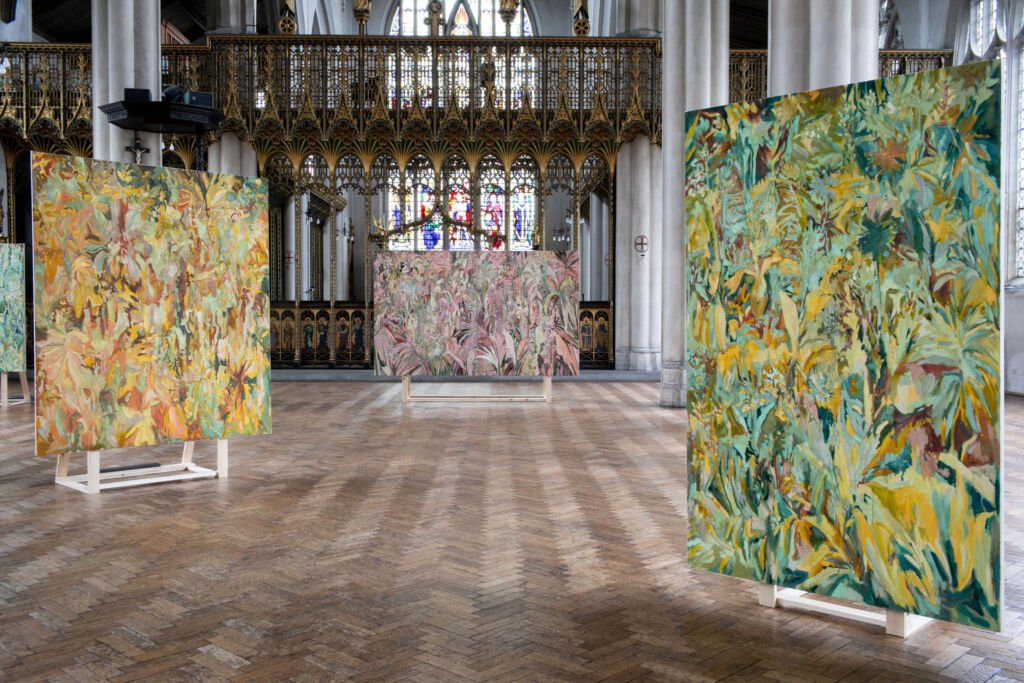
‘andante’ Beatrice Hasell-McCosh, 2024, St. Cyprian’s Church. Photo: Hermione McCosh
APSARA is delighted to present “Andante,” a solo exhibition by London-based artist Beatrice Hasell-McCosh. As part of our public program, artist Aliaskar Abarcas will facilitate a unique sonic and somatic workshop at St. Cyprian’s Church in Marylebone.
To encounter Beatrice Hasell-McCosh’s work is to step into a multi-sensory picturesque world of poetry, nature and song. The paintings and watercolours, defying their two-dimensional bases, bend, fold and flourish with life, swaying to the rhythms of Hasell-McCosh’s strokes. Apsara Studio is delighted to present ‘andante’, a major solo show curated by Jenn Ellis at St. Cyprian’s Church, Marylebone, London. With an emphasis on harmony and tempo, ‘andante’ invites us to discover new paintings within the form of a bespoke installation that responds to the neo-gothic interiors of the site. A Graduate from the Royal Drawing School with a background in English and Classics, Hasell-McCosh collects sources of inspiration from music to set design, comics, 1950s adverts, Chagall’s stained glass, poetry, and tapestries. In her first solo exhibition since her major Garden Museum presentation, ‘andante’ is a nuanced encounter around the endless cyclicality of the natural world.
Both painterly and scientific, refined yet rough, delineated yet abstract, Hasell-McCosh’s works conjure an essence of movement, that sense of ‘rustle’, ‘bristle’ or sway. In their vibrancy, they both meet the natural world’s delicate essence and reveal components, elements and exchanges that only a keen observer would somehow note. Hasell-McCosh’s paintings are the result of time and deep familiarity; repeated encounters with the world of plants in all their guises so as to know their names and feel their changes – like close friends, or family. Steeped in the world of botany yet drawing inspiration from various sources, Hasell-McCosh’s oeuvre is a pluralistic masterpiece that oscillates between assiduous narration and elementary feeling. Indeed, deep observation of Hasell-McCosh’s paintings often feels as if there are multiple worlds, one layered atop the other, overlapping with senses of survival, care and tender play.
Seeking organic truths rather than constructed perfection, Hasell-McCosh is influenced by the Japanese idea of Kintsugi. Finding beauty in imperfection, her works bring us closer to the natural world as well as that of our own varying humanity. Through the study and observation of naturalistic gardens, Hasell-McCosh assumes a role of profound engagement with the environment; indeed, each painting is based on a combination of instinct and memory, what has been seen and recorded in a drawing giving way to mnemonic recollection and feeling. Swathes of short-flowering annuals overlap, embracing the beauty of impermanence – a duality of existence. A duality that also exists in her sources of inspiration; the public natural world around her and the private space of her home in Cumbria. Growing up, she was surrounded by a garden ‘constructed’ by her mother and her extraordinary knowledge. Built with time, care and creativity, Hasell-McCosh channels its continuous temporality, creating a reflection of the inner and outer worlds: the spaces we pass through and those intimate places we inhabit and grow with.
Each painting balances a meditative gesturality with a rooting in our everyday culture. Through Hasell-McCosh’s titles, she introduces a cheeky sense of play and referentiality. ‘CRASH, BANG, WALLOP’ (2024), for example, nods to Dennis the Menace and the Bash Street Kids, a nod that is further carried forward by choosing a colour palette from the cartoons. Another piece, ‘Beautiful and Useful’ (2024), rephrases William Morris’ famous expression, while ‘Millions Of Dollars And Countless Jobs’ (2023) is a quotation from a Miranda Priestly speech in The Devil Wears Prada. Hasell-McCosh is also interested in the double action of lure and convey; how works or associations with beauty or prettiness can in fact prompt thought or reflection on deeper and more sinister topics ranging from feminism to safety. Intentional and intriguing, the titles create a bridging point between the worlds of visual meditation and wider observations around the actualities of everyday life.
Set in the architectural gem that is St Cyprian’s Church, ‘andante’ is conceived as a multi-layered encounter and moment to step into, away from the noise of the quotidian. Located in a place of active worship, the works sing to the site’s exploration of cyclicity, bridging a connection between the natural and spiritual worlds. The diptych paintings, such as ‘Dead or Alive’ (2023) and ‘That’s the Tea’ (2023), also cast a further nod to altar pieces, in particular the Ghent Altarpiece by Hubert van Eyck and Jan van Eyck. With an emphasis on creating visual dialogue and harmony with the church’s volumes and architectural details, each of the paintings stand within the space, off the ground, as free-standing windows into another universe. Drawing inspiration from studio easel display systems and the modernist display stands in Philip Johnson’s The Glass House, each painting provides a distinct point of breath and overlap.
Ultimately, ‘andante’ is a change of pace, an invitation to take a walk through Hasell-McCosh’s visual garden and reflect on the notes of imperfection, connection, cultural cues and harmony; the various elements that make up our cyclical and oscillatory natural worlds.
Text by Jenn Ellis
Beatrice Hasell-McCosh Interviewed by APSARA
‘Flowers and colour already represent so much and have different meanings in different cultures. It adds depth to the work for me when I’m able to bring in these additional references.’
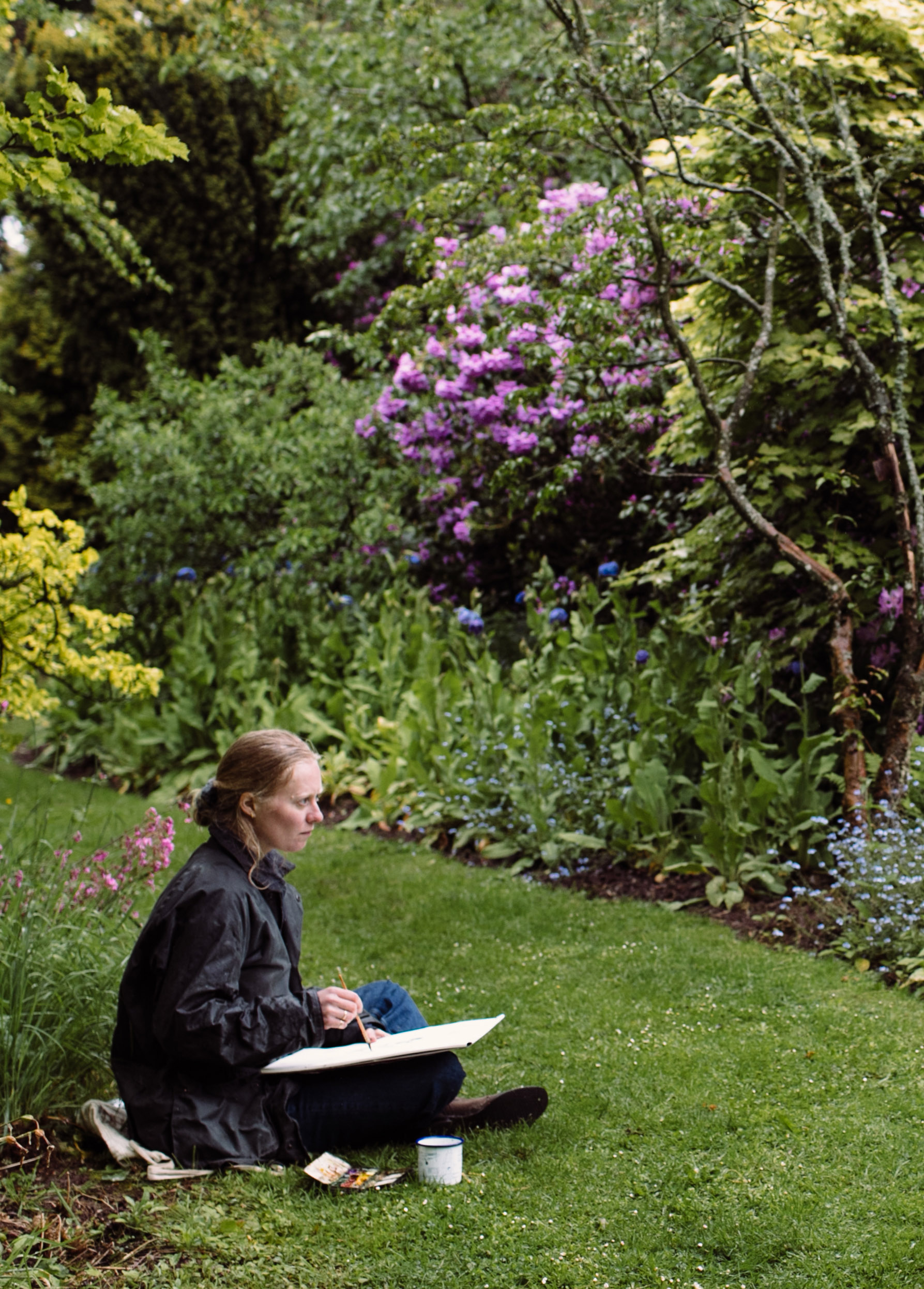
We are extremely excited to be working together on your next solo at St Cyprian’s Church in London. More so, we were impressed to get to know a pluralistic world of inspiration you draw from that includes Classics, phytology, botany, poetry, comic book strips and tapestry, to name a few. Could you tell us a bit about your background and which of these interests you will tap into for this exhibition?
I studied at Leith School of Art in Edinburgh and then the Royal Drawing School in London but before that my degree was in English and Classics at University so reading widely around a subject was quite a natural element of my practise when I started painting. Flowers and colour already represent so much and have different meanings in different cultures. It adds depth to the work for me when I’m able to bring in these additional references.
Current interests include historic wallpaper and tapestry – I love the Hardwick Tapestries in the V & A which are in this huge church-like, darkened room up in the top of the building. I love murals too, anything on a large scale which gives the feeling of being enfolded by a world. In the same way I love light installations such as work by James Turrell, or architectural space – Tadao Ando buildings on Teshima Art Island were extraordinary to be inside.
With my own paintings, they begin with small drawings, done from life. These then act as reference points for larger paintings done in my studio in London, mostly from memory. The drawings sit in a plan chest and I bring them out over a period of time to draw inspiration from. It’s become harder and harder to let these go as they can galvanize thoughts and new work even years after I first make them.
You are not only an artist, but a visual botanist whose practice blends a scientific knowledge of plants with a sensitivity to our relationship with the living world. How does a visual botanist observe and experiment in attempt to investigate and collide the intersections of science, the natural world and art?
It’s really kind to be described as a visual botanist, ironically In real life i am worryingly bad at keeping plants alive. I like the concept of collection of knowledge though, like historic plant hunters. My mum is an extraordinary and creative gardener and her passion and knowledge was something very cool to be able to connect with during 2020 when I spent so much time drawing in the garden at home and collecting information. I was tapping into her extensive experience and knowledge and thought process for constructing the garden and my works are reactions to all this information, trying to create that same feeling that someone else can then experience in a different way.
Visually, your references to botany and pattern could be seen as linked to a tradition that recalls the Arts and Crafts movement, in particular, the works of May Morris. Politics were at the centre of Morris’ work. Do you see your own work as political and/or what is its societal engagement?
I do think that all art has something to say and engagement with the world you live in is important. This engagement is also something that happens fairly naturally, i’m a woman living in the world today and there’s a lot to talk about.
What I like is the dichotomy between often uncomfortable political thoughts and the ‘pretty image’; to be drawn in by colour and texture and to stay for the back story of the art historical, contemporary culture or feminist references. May Morris was good at this; using needlework and embroidery, docile domestic crafts (a ‘womans hobby’) to pack a feminist punch and to strive for equality.
‘Stay Sexy & Don’t Get Murdered’ is an example of this, the title of the work is from a Ted talk by Jason Katz about violence against women being a passive action that women allow to happen. It’s a striking soundbite and yet the painting is made of pinks and soft bright colours which have been historically linked with ‘the fairer sex’, weakness or feelings of delicacy. I have purposefully muted these colours and when you get up closer it feels much greyer, less vibrant and more complicated than on first view.
You mentioned you’re inspired by Kintsugi and the idea of beauty in imperfection. How is your artistic approach shaped by this sensitivity and methodology?
When I begin I never have a solid idea of what a work will look like. The mistakes, drips and shapes that emerge during the first laying down of paint then inform the structure of the marks as I go along. The only thing I know from the outset is colour choices and I usually work with a limited palette of 3 or 4 colours per work. The architecture of the negative shapes is something that is important in the final work as much as the recognisable figurative elements. Imperfection and the unplanned is often the thing that brings a work together at the end which is why it’s beautiful.
Being in your studio, we were struck by the mixed emotions one feels when confronted by the immersive and at times grotesquely populated world of your large-scale canvases, in contrast to the delicacy of your watercolors. Could you talk about emotionality regarding the senses’ responses to color, shape and form?
I wanted to create worlds within worlds, something that takes over the viewers senses and immediate surroundings. Completely covering the canvas from corner to corner is therefore crucial to creating this experience. The layers of impasto paint add to this first impression of abundance. Colour provides a synthetic accessibility (the use of light bright colours often found in comic books or adverts) and then the heft of the shape and space within the painting co produces a narrative with the viewers own take on their experience of being in front of the work.
Painting is a way of processing things. For me it’s really like a form of meditation. This year has been extremely turbulent because of family illness. I have used painting as a way of processing thoughts and, also (in the same way you step out of your own world when you watch a film) it is a way of being elsewhere for a short time. My colours have become much brighter, having previously been full of earth tones, perhaps this is a form of manifesting positivity as well.
Thinking of St Cyprian’s Church, not just architecturally, but also as a place of deep reflection and communal being, how will the exhibition respond to the idiosyncrasies of the site?
I’m excited to share the form of the show and Jenn’s curation, each work will be freestanding like separate life forces or windows into various worlds.
Being in a church is also extremely relevant to the origins of the paintings as well. During lockdown people weren’t able to go to churches, which were closed, instead nature and gardens became something that people (and I) aspired to almost worshipped in the news. Rightmove searches for houses with gardens went up 200%. Works done then in diptych form were referencing altar pieces – the Ghent Alter piece particularly – where multiple shaped parts make up a whole.
The mediation aspect of drawing and being in nature was something I found comforting during that period of time and as the paintings developed it also allowed me the space and opportunity to grow my work in scale and concept. Being at St Cyprians Church allowed for large scale imagination for the curation which is expansive and exciting.
Beatrice Hasell-McCosh (b.1990, UK) studied English and Classics at Leeds University and then spent two years studying at Leith School of Art in Edinburgh and The Royal Drawing School in London. Her work is in private collections around the UK, around Europe, Japan and the USA. Most recently her work has been acquired by the Royal Collection Trust and the Garden Museum. She has curated two exhibitions, both focusing on the importance of drawing. Her first museum solo presentation was at the Garden Museum in London in June 2022. This year she has exhibited in ‘All This Wrath’ and ‘Works on Paper 6’ at Blue Shop Galleries (London), ‘Moments of Glad Grace’ at Abbott & Holder (London), ‘Spring’ at Eastwood Fine Art (Hampshire) and RHS Chelsea Flower Show (London). She lives and works in London.
